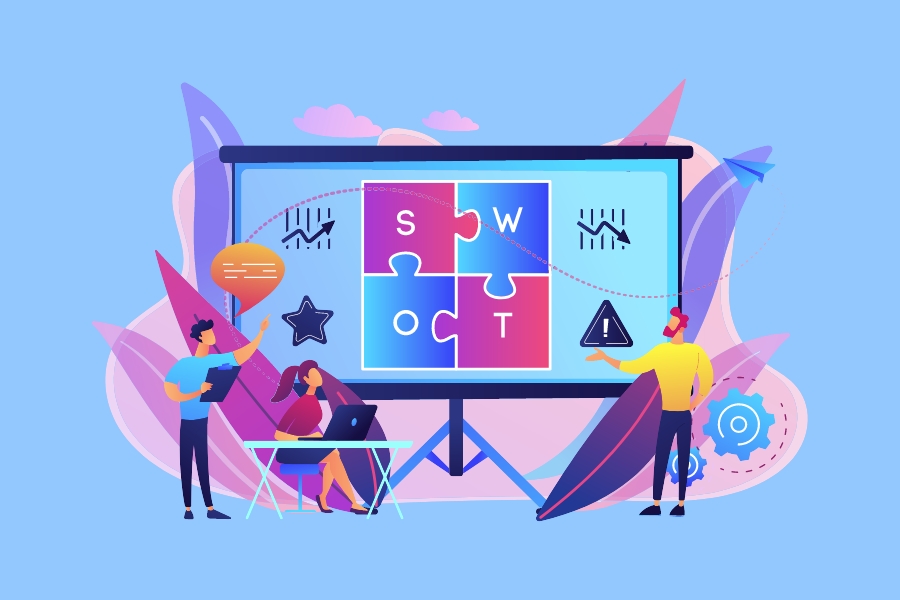So, you’ve heard about the SWOT analysis but searching for a deeper understanding of how it works?
You’ve landed in the right spot!
In this guide, we’re going to unravel this mysterious yet practical marketing tool and, more importantly, how to use it to boost your business.
Whether you’re running a personal brand, a small business, or a large corporation, we’ve got specific, actionable techniques to empower you to turn threats into opportunities and weaknesses into strengths.
Ready for some transformative insights?
Let’s dive right in.

What is a SWOT Analysis & Why Should You Use it?
A SWOT analysis is an incredibly powerful marketing tool when understood and used correctly.
It’s about developing a holistic understanding of your business environment, both internal and external.
SWOT stands for Strengths, Weaknesses, Opportunities, and Threats.
The SWOT framework helps you examine internal factors (strengths and weaknesses) and external factors (opportunities and threats) that can impact your business plan.
By taking a more in-depth look at what it involves and how to implement it properly, you can make the most of this strategic planning tool.
So, when should you use SWOT Analysis?
It’s useful when planning a new venture, assessing an existing enterprise, or even evaluating a potential change in direction.
From a strategic management perspective, SWOT Analysis acts as a beacon, illuminating pathways for growth and identifying potential pitfalls.
The 4 Key SWOT Analysis Components

Before embarking on your SWOT Analysis journey, let’s get familiar with its key components…
Strengths
Strengths are the first internal factor and represent your business’s assets, the things you do exceptionally well that differentiate you from your competitors.
But it’s not just about listing your internal strengths; it’s about truly understanding them and how they contribute to your overall competitive advantage.
For instance, you might consider a well-established brand name as a strength.
But take a step further and ask, why is it a strength? Is it because it evokes a sense of reliability and trust among customers? Or because it allows for better market penetration and reach?
The deeper you dive, the more valuable your analysis becomes.
Weaknesses
Acknowledging weaknesses (the second internal factor) can be challenging, but it is a vital aspect of SWOT analysis.
You see, understanding internal weaknesses allows you to plan how to minimize or overcome them.
For example, if your business has a limited social media presence in an increasingly digital world, this can be seen as a weakness.
However, acknowledging this, you can strategize ways to enhance your online visibility — perhaps by boosting your social media engagement, optimizing your website, or investing in digital marketing.
By turning a critical eye on your business, you pave the way for improvement and growth.
Opportunities

Opportunities are the first external factor that can benefit your organization if capitalized upon.
They might be related to market trends, technological advancements, policy changes, or shifts in customer behavior.
Understanding external opportunities isn’t just about recognizing them; it’s about being proactive in seizing them.
For instance, the growing demand for eco-friendly products could be an opportunity for a business that produces sustainable goods.
However, it will remain only a potential advantage unless you take steps to exploit it, such as marketing your commitment to sustainability or developing new green products.
Threats
Lastly, threats are another external factor that could potentially harm your organization.
They might include aggressive competition, regulatory changes, market contraction, or supply chain disruptions.
Identifying threats is the first step in creating a defensive strategy to mitigate potential damage.
Consider a business operating in a rapidly changing industry such as technology. The constant emergence of innovative, potentially disruptive technologies could pose a threat.
By recognizing this, you can plan to stay ahead through continuous research and development or strategic partnerships.
Bringing it Together into a Strategic Plan
SWOT analysis should not be conducted in isolation; the four elements interact with each other.
Strengths can lead to opportunities, while weaknesses might expose your business to threats.
Let’s consider a SWOT analysis example. A business with a strong research and development department (strength) might be well-positioned to seize opportunities in an emerging market.
On the other hand, a business with poor customer service (weakness) might risk losing market share to competitors (threat).
By understanding these interactions, you can create robust strategies that harness your internal strengths, mitigate your weaknesses, exploit external opportunities, and counteract threats.
And remember that a SWOT analysis is not a one-time event. It should be repeated regularly to reflect the dynamic nature of business. As your strengths grow or new threats emerge, your strategy should adapt.
The real power of SWOT analysis lies in its ability to help you continually align your business strategies with your capabilities and the external environment.
6 Beginner-Friendly Steps That’ll Help You Conduct a SWOT Analysis

Understanding the concept of a SWOT analysis is a fantastic start, but to truly reap the benefits, you need to know how to execute it effectively.
Here is a step-by-step guide on how to conduct a comprehensive SWOT analysis, complete with examples and tips for each phase of the process…
Step 1: Identifying Strengths
The first step in a SWOT analysis is to identify your organization’s strengths.
This involves taking a close look at what your organization does exceptionally well. Strengths can be tangible or intangible, ranging from skilled staff and financial resources to a positive brand image and loyal customer base.
To identify your strengths, ask yourself questions like:
What does our company do better than our competitors? What resources do we have that they don’t? What do customers praise us for?
For example, a high-end restaurant’s strength might be a team of award-winning chefs, a unique menu, and an excellent location.
Step 2: Pinpointing Weaknesses
Recognizing weaknesses requires introspection and honesty. These are areas where your organization falls short, or where others have an advantage.
This might include aspects like poor online presence, inadequate customer service, or high staff turnover.
To Identify your weaknesses, consider:
What do customers complain about? Where do we lose to our competitors? What internal processes need improvement?
For instance, a retail company might identify slow delivery times, a lackluster website, and high product return rates as weaknesses.
Step 3: Spotting Opportunities

Opportunities are external conditions that, if capitalized on, can lead to success. They can come from market trends, technological advances, changes in consumer behavior, or even new legislation favoring your industry.
Spot opportunities by examining your business environment. Consider:
What trends or changes could we benefit from? Are there emerging needs for our products/services?
For a tech startup, opportunities might include the rise of remote work, creating a demand for their productivity software, or favorable new tax laws for software companies.
Step 4: Recognizing Threats
Threats are external factors that could cause trouble for your organization. These can include new competitors, regulatory changes, economic downturns, or a declining customer base.
To recognize threats, monitor your industry and market regularly. Ask yourself:
What obstacles do we face? Are changing regulations or market trends hurting us? Are our competitors gaining ground?
For a brick-and-mortar bookstore, threats might include the growing popularity of e-books and online retailers or increasing commercial rent prices.
Step 5: Analyzing and Prioritizing
After compiling your list, the next step is to analyze the findings and prioritize.
Not all points will have the same impact, so you should focus on the most significant strengths, weaknesses, opportunities, and threats.
Use a decision matrix to help you prioritize. Consider each point’s potential impact on your business and the resources required to address it.
Step 6: Developing Strategies
The final step is to translate your analysis into actionable strategies. This involves leveraging strengths and opportunities, mitigating weaknesses, and developing contingency plans for threats.
Make sure your strategies align with your overall business objectives. For instance, if customer retention is a goal, a strategy could be improving customer service by addressing a weakness identified in your SWOT analysis.
PEST Analysis & TOWS Analysis

While the SWOT analysis is a powerful tool in its own right, it doesn’t exist in a vacuum. Pairing it with other analysis techniques can provide a more comprehensive view of your business environment…
PEST Analysis
PEST analysis, which stands for Political, Economic, Social, and Technological analysis, is a tool that can shed light on the broader macro-environmental factors that can shape opportunities and threats to your business.
A PEST analysis complements your SWOT by identifying external factors that could impact your business, offering a broader perspective on the landscape in which your organization operates.
So, use PEST analysis as a guide for anticipating changes in your market and for identifying new opportunities and threats that might not be immediately apparent through a SWOT analysis alone.
TOWS Analysis
If you’ve never heard of TOWS, you’re not alone — but it’s an incredibly powerful tool when paired with SWOT.
The TOWS Matrix is essentially SWOT flipped on its head.
It provides a structured way to think about how you can use your strengths to capitalize on opportunities (SO strategies), mitigate threats (ST strategies), minimize weaknesses using opportunities (WO strategies), or manage weaknesses to avert threats (WT strategies).
Use the TOWS matrix as a follow-up to your SWOT analysis. Once you’ve identified your strengths, weaknesses, opportunities, and threats, the TOWS matrix can help you think strategically about how these elements can interact and influence your business strategy.
Ready to Level-Up Your Game by Using SWOT Analysis?

And there you have it — the powerful world of SWOT Analysis, decoded and ready for you to take your business to new heights!
You’ve walked through the what, the why, and the how, and now you have a roadmap to outmaneuver your competition.
So, the ball is in your court.
Go ahead, take that first step, make that SWOT grid, and make this a breakthrough year for your business!



